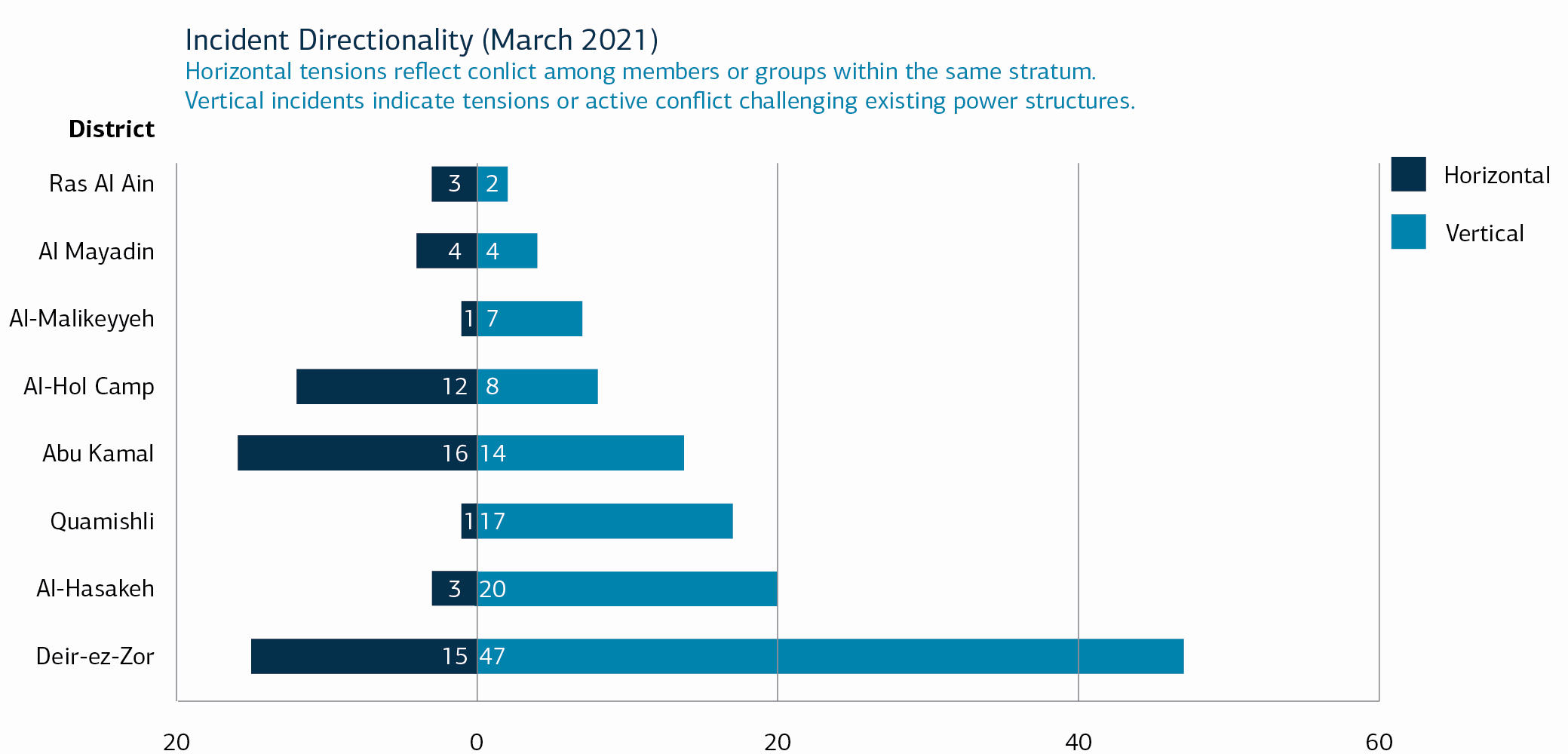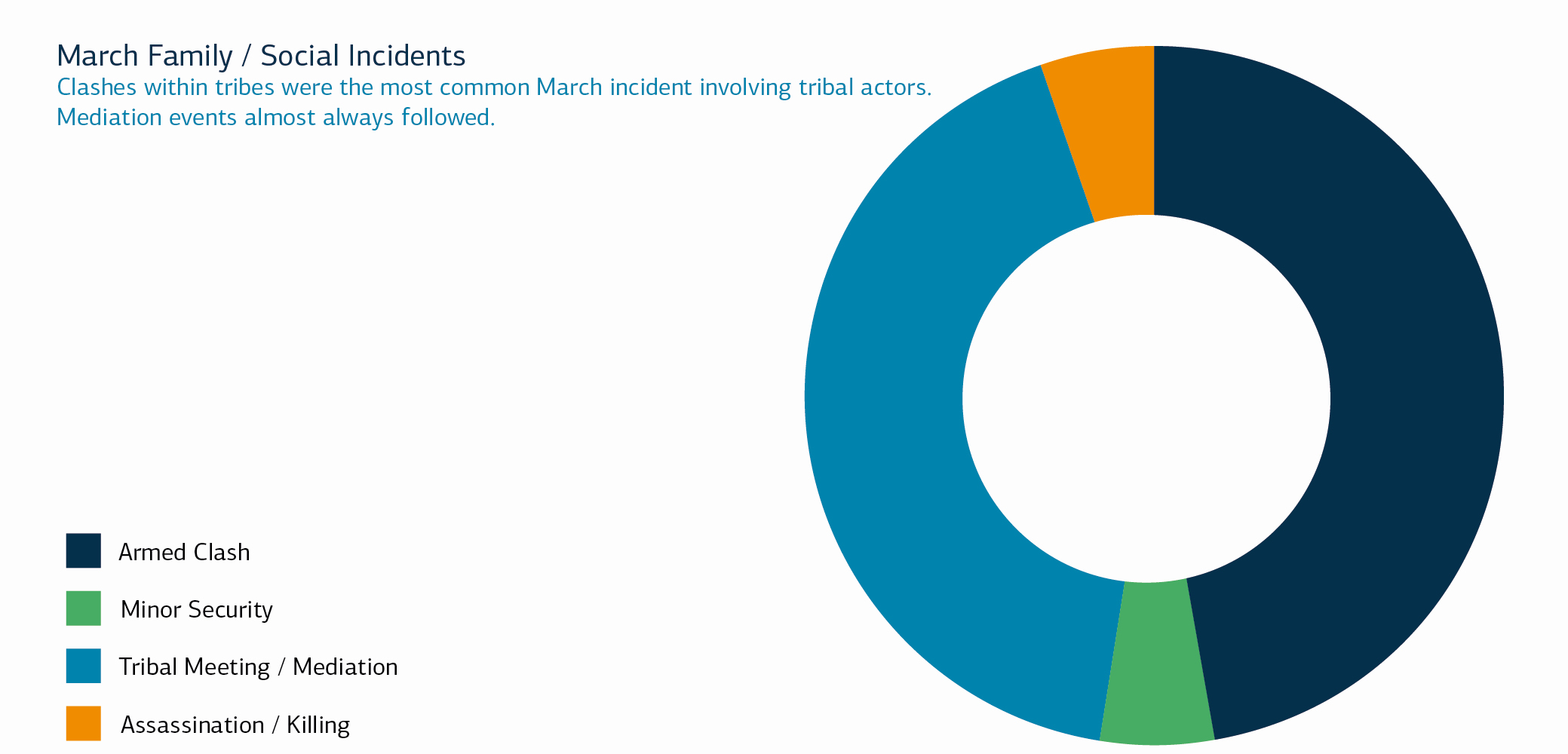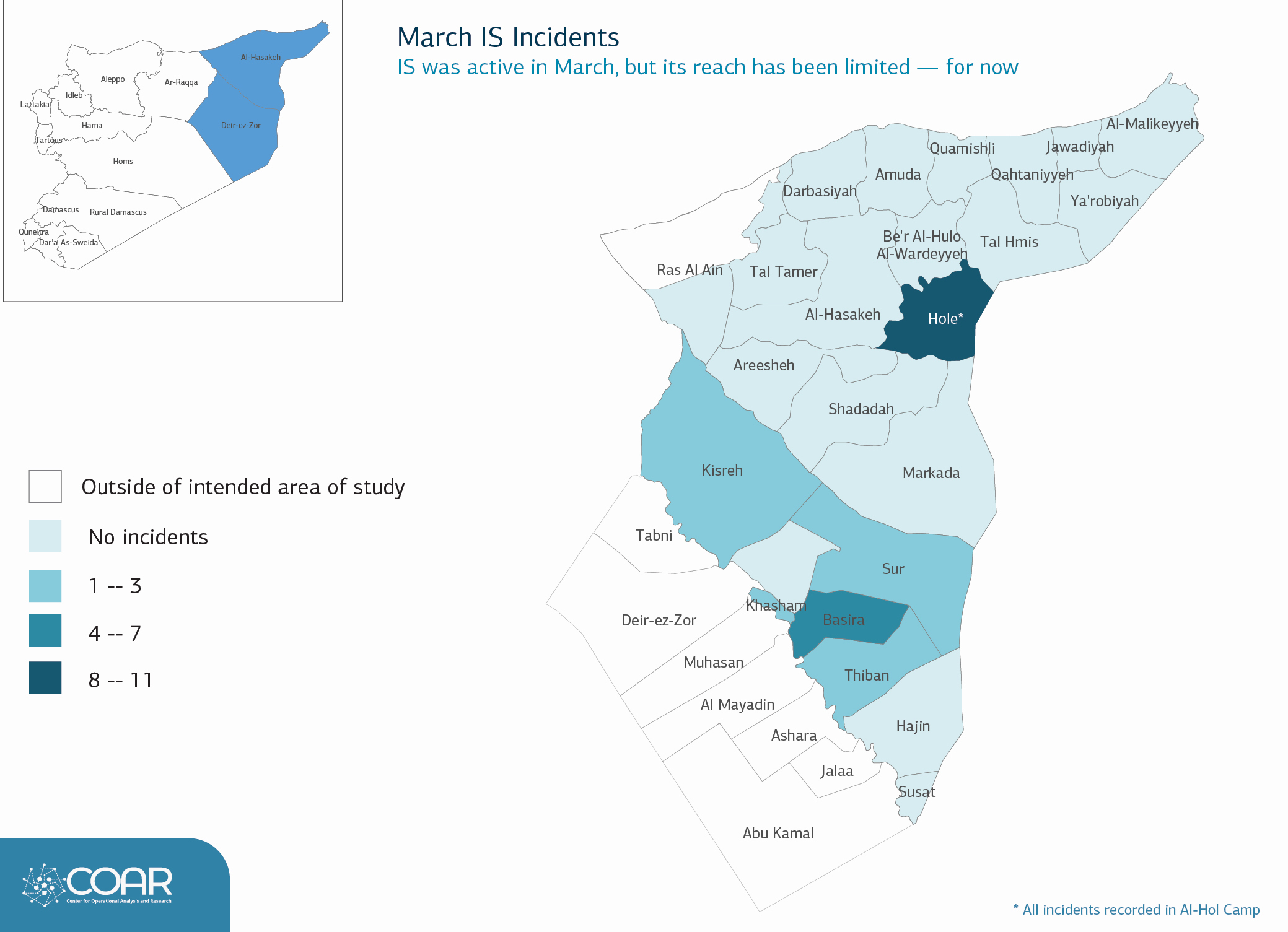[dflip id="52930"][/dflip]
Introduction
This report introduces an ongoing pilot study by COAR to monitor stability and social tensions in northeast Syria. Building on COAR’s previous work on Syria’s eastern region, the project employs incident monitoring through data collected and verified by COAR field researchers and classified according to a broad set of predetermined stability and social tension indicators. This report presents initial data collected in the month of March 2021, and it focuses in large part on Arab tribes in the region. Arab tribesmen represent a majority population in every major community in northeast Syria, and they are a plurality or sizable minority in nearly all such communities. To understand the issues affecting the region’s tribes is to better understand the region itself.
In its totality, this project sets out to identify the most relevant factors now shaping the operational environment for donor-funded aid activities, stabilisation initiatives, and political and strategic decision-making concerning northeast Syria. As active conflict in Syria slows and regional borders harden, it will become increasingly important for international relief and non-humanitarian initiatives to grapple with the local and regional conflict-drivers that this project aims to assess.
Methodology
Geography
This report concerns data collected in the month of March 2021 from Al-Hasakeh and Deir-ez-Zor governorates. The portion of Deir-ez-Zor that lies outside the control of the SDF and is, therefore, beyond the reach of most donor-funded activities, is excluded. Moreover, al-Hol camp is assessed as a standalone geography due to its unique status and the contrast in observed incidents between it and the surrounding Al-Hasakeh countryside. The incidents recorded are verifiable physical incidents.
Classifications
Two local field researchers based in Al-Hasakeh and Deir-ez-Zor governorates collected incident data directly and through their personal networks of local sources and field observers. In conjunction with these researchers, COAR has analysed incidents and classified them on a preliminary basis in several ways. In addition to basic information regarding actor identity and geography, incidents have been grouped according to a set of broad thematic categories. Most importantly for the purpose of assessing stability, COAR has classified incidents according to their directionality vis-à-vis local social and power dynamics. Incidents that reflect tensions within or between social groups of roughly equivalent power or standing are classified as having a horizontal direction. By contrast, incidents that reflect tension or conflict between local actors and formal or de-facto authorities or power structures are classified as being vertical in nature.

Tribesman against Tribesman, not Tribe against Tribe
Arab tribes are unquestionably an important social force in eastern Syria. However, the precise roles played by tribes in the political, security, and governance spheres are frequently misunderstood (See: Tribal Tribulations). Quantifying how members of tribes engage each other and various authorities is therefore an important first step toward mapping the broader stability dynamics of eastern Syria.
The March monitoring data offer a few preliminary insights regarding tribes’ disproportionate role in governance, social, and security affairs. Primarily, the incidents suggest a high degree of tribal insularity. Roughly three-quarters of incidents in which the main actor is affiliated with a tribe, the other involved parties were actors from the same tribe. Crucially, in no recorded incidents did tribes clash with other tribes. In the recorded events, such events were often triggered by personal disputes over economic issues (e.g. land use), and in several cases they represented a relapse of a pre-existing interpersonal dispute. That said, a large proportion of events showed tribal mediation at work. Approximately 40 percent of all events involving tribes were tribal meetings (8) that either aimed to mediate tribal disputes or address broad-based social issues such as community, security, or military conscription. Tribes’ capacity to mediate such conflicts is especially critical given the limited legitimacy of the SDF and Asayish among such networks.
Historical experiences of marginalisation and conflict are also reflected in the March data. Geographically, Hajin, Basira, and Susat districts in southern Deir-ez-Zoe Governorate witnessed the greatest concentration of incidents involving tribal actors (15 events). Notably, these districts are among the most chronically underserved in all of eastern Syria: Squalid living conditions, SDF security campaigns, and fuel shortages have prompted protests and other social flare-ups in these areas in the past. Meanwhile, only three incidents — two assassination attempts and a tribal meeting — were reported in all of Al-Hasakeh Governorate. In terms of tribal actors, Al-E’keidat tribe was involved in more incidents than any other tribe, predominantly intra-tribal incidents and mediation events. Al-E’keidat is among the tribes that has been most heavily involved in social tension events in the past, which have widened cleavages within and among the tribe’s families.

IS and the Tribes
Despite its territorial defeat in March 2019, the Islamic State (IS) remained an important actor in northeast Syria in March 2021. The data show IS or IS-affiliated individuals were involved in 28 events. Of these, nearly 40 percent occurred in al-Hol camp, which witnessed a large-scale SDF-led security campaign. All other IS-linked incidents were recorded in various locations across Deir-ez-Zor Governorate. As seen with an uptick in IS attacks in Homs and Hama, IS-linked incidents in Deir-ez-Zor in March were primarily confined to hit-and-run attacks.

IS has increasingly hewed to a domestic, localised agenda that has particular significance for marginalised regions with large Arab tribal populations. March data suggest that IS is seeking to capitalise on harsh economic conditions and the hostile relationship between local communities and the SDF for recruitment. Roughly 51 percent of all monitored events (88 in Deir-ez-Zor) took place in communities in eastearn rural Deir-ez-Zor Governorate, among the areas most heavily impacted by poor economic conditions within the entire study area. Additionally, members of the SDF or affiliates of the Autonomous Administration, or their local interlocutors, were the main targets of attacks across the northeast. This suggests an intent on the part of IS to undermine local governance and raise the cost of cooperation with the Autonomous Administration and its affiliated security forces. In response to pressures such as these, on 11 March, eight members of the newly established civil council in Basira, central Deir-ez-Zor, resigned due to security concerns. Interestingly, no recorded March incidents involved a direct interaction between tribal actors and IS. The absence of such events is likely a result of the inchoate IS group’s efforts to attract Arab tribesmen to join its ranks.
SDF and the Tribes
The relationship between the SDF and local communities is one of the most important for stability in northeast Syria. The SDF’s engagement with local communities is not uniform, although a considerable proportion of all incidents involving the SDF were counter-IS operations. That said, the patterns of regional incidents in March vary according to security, geographic, and social factors. In Deir-ez-Zor Governorate, the SDF largely pursued security objectives, and more than 61 percent of events (38 incidents) involving SDF in the governorate were arrests, security campaigns, or clashes with local actors. Events of this nature accounted for 44 percent of SDF-related incidents (16 in total) in Al-Hasakeh (outside al-Hol camp), while all of the observed events in al-Hol Camp were security-driven.
After community insecurity (e.g. robberies, petty crime, etc.), restrictions on accessibility, poor services, and governance decisions made by Autonomous Administration authorities were the primary trigger of incidents, protests, and strikes. Eight protests were recorded against the Autonomous Administration in communities in Deir-ez-Zor such as Hajin, Abu Hamam, Mhemideh, Lower Safira and Gharanij. Most notably, the decision to terminate the contracts of 264 Deir-ez-Zor Civil Council workers prompted a series of protests north of Deir-ez-Zor city.
The combination of local instability, poor services, and the limited capacity of the Autonomous Administration to respond to local security and social tensions are among the factors that have prompted Arab tribes in Deir-ez-Zor (and to a lesser extent in Al-Hasakeh) to distance themselves militarily and socially from the SDF. This has manifested in two ways: first, frequent reliance on local tribal councils for mediation of local disputes and the enforcement of tribal law or custom; second, moves to establish tribal military groups resembling the Shammar tribe’s Sanadeed forces. Although nominally under the command structure of the SDF, such militias aim to bring operational autonomy to the tribes by allowing them to complete military service in their own communities.
While security has been the main concern of the SDF in Deir-ez-Zor Governorate, the struggle for influence plays a role in shaping the SDF’s geopolitical engagement strategy in Al-Hasakeh Governorate. The multiplicity of controlling actors in the governorate, especially the joint control of SDF and Government of Syria over Al-Hasakeh and Quamishli city, has been a major source of instability in both cities, which has resulted in clashes and restrictions on mobility.
Incident Orientation
Over time, the changes to the orientation of incidents is expected to be a key indicator of stability writ large. Horizontal incidents, i.e. incidents that affect actors or groups across a single social stratum, can be seen as one indicator of social cohesion, or its absence. Vertical incidents — that is, incidents showing tension between formal or de facto authorities and population groups — can be seen as one (of many) indicators of challenges to popular legitimacy for governing authorities, in this case the Autonomous Administration.
Two-thirds of recorded March incidents showed vertical tensions. The majority of these events concerned protests against local authorities, or were responses to security operations by authorities. On a fundamental level, vertical incidents in northeast Syria reflect the hostile relationship between controlling actors and local communities (e.g. in Deir-ez-Zor), and to a lesser extent, the influence of international actors (e.g. Al-Hasakeh and Quamishli). One notable dimension of the tension over administrative legitimacy is service-related events, which were numerous and predominantly vertical.
One-third of recorded events showed horizontal tension, primarily concerning minor social tensions. Horizontal events were recorded in Abu Kamal, Ras Al Ain, and Al Mayadin districts and al-Hol camp.





